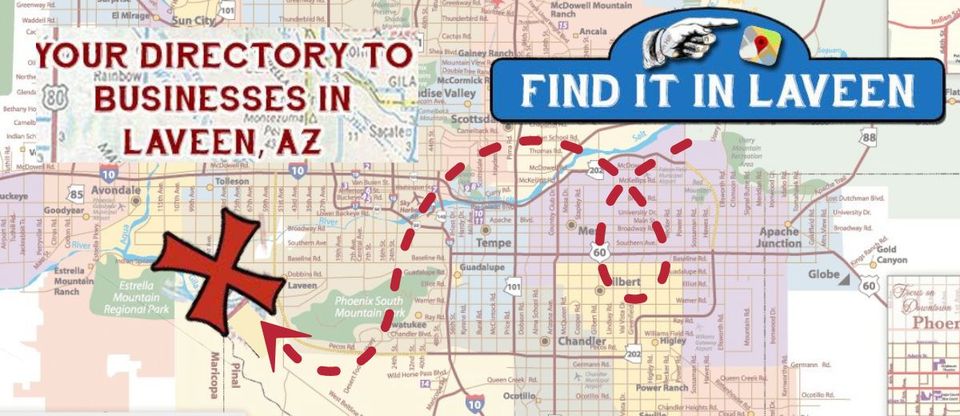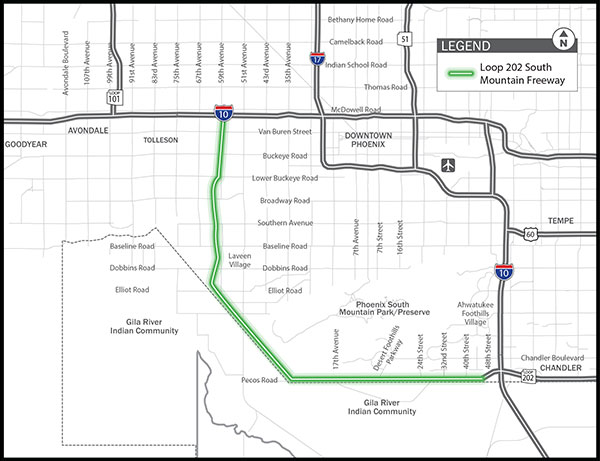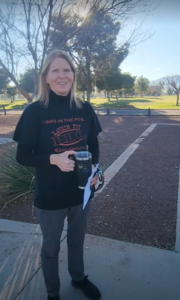This article appeared in the September edition of the South Mountain District News
Construction begins this month on the southeastern portion of the South Mountain Freeway after an August court decision ruled in favor of state and federal transportation officials who deem the 22-mile stretch of freeway that will link Interstate 10 to the Loop 202 “a necessity” to accommodate exponential growth predicted in Laveen and the southwest Valley.
“It really validates what motorists already know. Without this freeway, our local roads are going to suffer even greater congestion,” said Dustin Krugel, spokesman for the Arizona Department of Transportation. He said the Phoenix area is expected to grow by 2 million people from 2010 to 2035.
“The southwest valley is where the growth will be concentrated over the next few years. Half of that growth will be people who will use this freeway,” he said.
Opponents filed separate lawsuits seeking to stop the long-planned freeway arguing that ADOT, the Federal Highway Administration and other government entities had failed to adequately address the environmental and cultural impact of the roadway. The route, which roughly follows 61st Avenue south from I-10 then curves around South Mountain to meet with Loop 202 in the southeast Valley, cuts through a portion of South Mountain Park Preserve and runs adjacent the Gila River Indian Community.
“For us, this is our lives on the line,” said Andrew Pedro, a member of the Akimel O’odham Youth Collective and G.R.I.C. “This is not just a win or lose court case. This is thousands of years of history and it’s a part of our spirituality. These places do give us strength and we have to defend these places. It’s not a one-off court case for us.”
Native Americans refer to the mountain as Moadak Do’ag and consider it a spiritual and holy place filled with tribal history.
The first public meeting to discuss design proposals more specific to Laveen is scheduled for 6-8 p.m. Wednesday, Sept. 28 at Betty Fairfax High School. Krugel said ADOT’s presentation will begin at 6:30 p.m. He said by November, there will be more specifics for when projects will be starting in the West Valley.
“This is the first of the public preliminary design public meetings,” Krugel explained. “In November, we anticipate more project kick-off public meetings that will have more details on construction plans.”
U.S. District Court Judge Diane J. Humetewa heard arguments in the court case in May 2016 and rendered her decision on Aug. 19 writing in the conclusion that the plaintiffs did not meet their burden to show the agencies’ actions were “arbitrary, capricious, an abuse of discretion, or otherwise not in accordance with law …” or “without observance of procedure required by law.”
Representatives from G.R.I.C. and P.A.R.C. (Protecting Arizona’s Resources and Children) and their affiliated groups say they plan to pursue an appeal through the U.S. Ninth Circuit Court of Appeal in San Francisco.
Pat Lawliss, president of P.A.R.C., said the appeal on behalf of her organization and several others, including homeowners groups and the Sierra Club, will be filed this month. She was bitterly disappointed by the judge’s ruling.
“It was more than disappointing. It was infuriating. It was a rubberstamp of what the government wanted,” Lawliss said. “The positives (about this freeway) are exaggerations and sometimes outright lies. What we are dealing with here is that the courts in Arizona, and even the federal court, are just rubberstamping things that the state government wants to do. I had hopes for better, especially from a Native American judge.”
Her position is echoed Palomba Allen, a Phoenix resident and member of the Gila River Indian Community. “I wasn’t surprised by the decision. I am definitely disappointed. It’s everything we’ve been fighting against.”
For Pedro, the decision is an incentive for his community to further unite against a common issue.
“Our collective is focused on organizing in the community. We’ve anticipated this for quite some time. These types of cases, well the majority of these don’t go in the indigenous people’s favor,” Pedro said. “There seemed to be a little more hope for this case because the judge herself is an indigenous person. But she ruled in favor of ADOT.”
Palomba said a recent G.R.I.C. council meeting resulted in a unanimous decision to appeal the court decision and an even broader, more historic decision for the Gila River community to collaborate in opposition to the freeway with its three sister tribes — the Tohono O’odham Nation, Also-Chin Indian Community and the Sal River Pima-Maricopa Indian Community. The leadership of the tribes meets monthly and in 1989 passed a resolution that all four would “protect, promote and preserve cultural affinity to the Huhugam.”
She said Huhugam translates loosely as “all used up,” in reference to their ancestors.
Krugel said construction will commence, regardless of potential legal threats to stop it with injunctions and appeals.
“From our perspective, it’s absolutely necessary for ADOT to move forward with construction to ensure the project remains on schedule and to prevent additional costs to taxpayers. The federal judge has already denied two attempts challenging the project.,” he said.
He said that ADOT has a duty to fulfill the voter-approved regional transportation plan.
“The sooner the freeway is built, the sooner ADOT will bring traffic congestion relief to Valley motorists by providing a needed east-west alternative to Interstate 10 through downtown Phoenix.”
Krugel said the $916 million contract for design and construction of this portion of the South Mountain Freeway makes it the largest highway project in Arizona history. It is also one of a few “megaprojects” nationwide that is a joint public-private project.
He said the developer also will be responsible for 30 years of maintenance following the completion of the project and the cost of the contract is fixed, so any overruns will be covered by the contractor and not taxpayers.
“There are a lot of incentives for the development team to do a good job and complete it on time,” Krugel said.
In addition to the meeting in September, Krugel said ADOT will host additional public meetings in late 2016 to share final design and construction plans with the public, and to provide more information on what to expect during construction.



